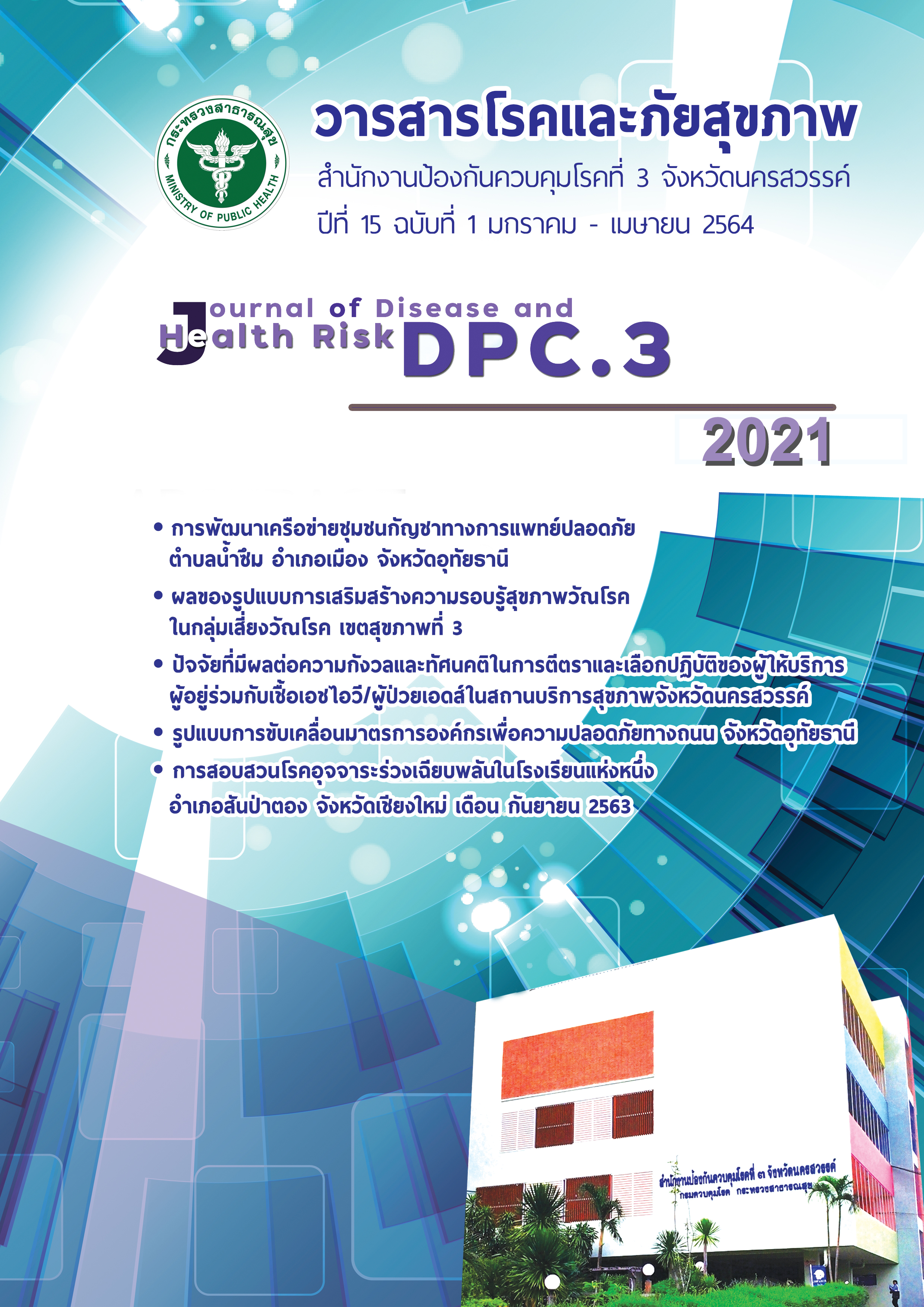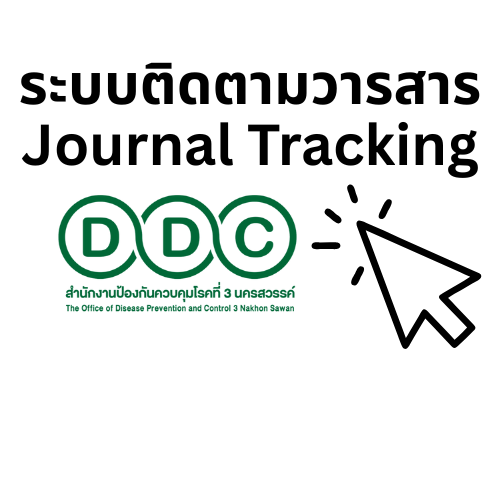ผลของรูปแบบการเสริมสร้างความรอบรู้สุขภาพวัณโรค ในกลุ่มเสี่ยงวัณโรค เขตสุขภาพที่ 3
คำสำคัญ:
กลุ่มเสี่ยงวัณโรค , รูปแบบการเสริมสร้างความรอบรู้สุขภาพวัณโรค, เขตสุขภาพที่ 3บทคัดย่อ
การวิจัยครั้งนี้เป็นการวิจัยเชิงกึ่งทดลอง (Quasi-experimental research) กลุ่มตัวอย่างเป็น 7 กลุ่มเสี่ยงวัณโรค คือ ผู้สัมผัสผู้ป่วยวัณโรค ผู้สูงอายุ 60 ปี ขึ้นไป ผู้ป่วยเบาหวาน ผู้ต้องขังในเรือนจำ ผู้ติดเชื้อเอชไอวี บุคลากรสาธารณสุข และแรงงานข้ามชาติ/ผู้อาศัยในชุมชนแออัด จำนวน 333 ราย สุ่มตัวอย่างแบบหลายขั้นตอน (Multi-stage sampling) จากฐานข้อมูลกลุ่มเสี่ยงวัณโรคที่ขึ้นทะเบียน ปี 2562 จำนวน 3,162 ราย มีวัตถุประสงค์เพื่อศึกษาผลของรูปแบบการเสริมสร้างความรอบรู้สุขภาพวัณโรคในกลุ่มเสี่ยงวัณโรคก่อนและหลังดำเนินการ แบ่งคะแนนเป็น 4 ระดับ คือ ไม่ผ่าน พื้นฐาน ดี และดีมาก วิเคราะห์ข้อมูลด้วยสถิติแจกแจง ความถี่ ร้อยละ ค่าเฉลี่ยเลขคณิต ส่วนเบี่ยงเบนมาตรฐาน และสถิติการทดสอบที ผลการวิจัยพบว่ากลุ่มตัวอย่างส่วนใหญ่เป็นผู้สูงอายุ 60 ปี ขึ้นไป จำนวน 113 ราย (ร้อยละ 33.93) รองลงมาเป็นผู้สัมผัสผู้ป่วยวัณโรค จำนวน 78 ราย (ร้อยละ 23.42) และผู้ป่วยเบาหวาน จำนวน 44 ราย (ร้อยละ 13.21) ตามลำดับ คะแนนเฉลี่ยความรอบรู้สุขภาพวัณโรคหลังดำเนินการสูงกว่าก่อนดำเนินการอย่างมีนัยสำคัญทางสถิติที่ 0.05 จากระดับพื้นฐาน (ร้อยละ 69.43) ไปสู่ระดับดีมาก (ร้อยละ 85.41) ผลของรูปแบบการเสริมสร้างความรอบรู้สุขภาพวัณโรคทำให้กลุ่มเสี่ยงวัณโรคมีความรอบรู้สุขภาพเพิ่มขึ้น เกิดความมั่นใจในการดูแลป้องกันตนเอง ครอบครัว และชุมชนให้ปลอดภัยจากวัณโรค ควรติดตามประเมินผลอย่างต่อเนื่องและปรับรูปแบบให้ทันต่อสถานการณ์โรคและภัยสุขภาพที่เป็นปัญหาในพื้นที่
เอกสารอ้างอิง
World Health Organization. Global tuberculosis report 2017. Geneva: WHO 2017:16-17.
World Health rganization.Implementing The End TB Strategy: The Essentials. Geneva: WHO 2015:18-19.
World Health Organization. Global tuberculosis report 2018. Geneva: WHO 2018:35-36.
สำนักวัณโรค กรมควบคุมโรค กระทรวงสาธารณสุข. แนวทางการควบคุมวัณโรคตามแผนปฏิบัติการระดับชาติด้านการต่อต้านวัณโรค พ.ศ. 2560-2564 [อินเทอร์เน็ต]. 2561 [เข้าถึงเมื่อ 8 ก.ย. 2563]: 18-19. เข้าถึงได้จาก: https://www. skko.moph.go. th/dward/document _file/aids/common_form_upload_file/20180911154249_1823529537.pdf
สำนักงานเขตสุขภาพที่ 3 กระทรวงสาธารณสุข. เอกสารสรุปผลการตรวจราชการและนิเทศงาน เขตสุขภาพที่ 3 รอบที่ 2 ปี 2562 [อินเทอร์เน็ต]. 2562 [เข้าถึงเมื่อ 8 ก.ย. 2563]. เข้าถึงได้จาก: http://spbo3.moph.go.th/ket/?p=2438
ชะนวนทอง ธนสุกาญจน์, วิมล โรมา, มุกดา สำนวนกลาง. แนวคิดหลักการขององค์กรรอบรู้ด้านสุขภาพ. หน้า8 กรมอนามัย หลักการขององค์กรรอบรู้ด้านสุขภาพ. ครั้งที่ 1. นนทบุรี: สำนักงานโครงการขับเคลื่อนกรมอนามัย 4.0 เพื่อความรอบรู้ด้านสุขภาพของประชาชน: 2561.
สำนักโครงการขับเคลื่อนกรมอนามัย 4.0 เพื่อความรอบรู้ด้านสุขภาพของประชาชน. สถานการณ์ความรอบรู้ด้านสุขภาพของคนไทย พ.ศ. 2562 [อินเทอร์เน็ต]. 2562 [เข้าถึงเมื่อ 1 ก.ย.2563]. เข้าถึงได้จาก: http://dohhl.anamai. moph.go.th/ewt_dl_link.php?nid=112
ประสพชัย พสุนนท์. การกำหนดขนาดตัวอย่างตามแนวทาง Krejcie and Morgan (1970) ในการวิจัยเชิงปริมาณ. วารสารวิชาการศิลปศาสตร์ประยุกต์ 2557:7;112-24.
เกียรติสุดา ศรีสุข. ระเบียบวิธีวิจัย. ครั้งที่ 1. เชียงใหม่: โรงพิมพ์ครองช่าง: 2547.
Likert, R. New Patterns of Management. New York: McGraw-Hill; 1961.
กรมสนับสนุนบริการสุขภาพ กระทรวงสาธารณสุข. การเสริมสร้างและประเมินความรอบรู้ด้านสุขภาพและพฤติกรรมสุขภาพ. นนทบุรี: กรมสนับสนุนบริการสุขภาพ: 2561.
จรัสศรี ศรีเวียง. ตำบลต้นแบบ ลดวัณโรค “ค้นให้พบ จบด้วยหาย พัฒนาเครือข่ายและระบบดูแลรักษา. [อินเทอร์เน็ต]. 2561 [เข้าถึงเมื่อ 1 ก.ย. 2563]. เข้าถึงได้จาก: http://203. 157.186.16 /kmblog/page_research_detail.php?ResID=888#
กิตศราวุฒิ ขวัญชารี, พรนภา ศุกรเวทย์ศิริ, กรรณิการ์ ตฤณวุฒิพงษ์. ปัจจัยที่มีความสัมพันธ์กับการป่วยวัณโรคปอดเสมหะพบเชื้อในผู้ป่วยเบาหวานของประเทศไทย. วารสารวิชาการสคร.7 จังหวัดขอนแก่น 2559:3:1-11.
ขวัญเมือง แก้วดำเกิง, ดวงเนตร ธรรมกุล. การเสริมสร้างความรอบรู้ด้านสุขภาพในประชากรผู้สูงวัย. วารสารวิจัยทางวิทยาศาสตร์สุขภาพ 2558;9(2):1-8.
ขวัญเมือง แก้วดำเกิง. [เอกสารประกอบการประชุมวิชาการสุขศึกษาแห่งชาติ ครั้งที่ 18 เรื่อง "การพัฒนาพฤติกรรมสุขภาพ ยุค 40" วันที่ 18-20 พฤษภาคม 2560 ณ โรงแรมจอมเทียนปาล์มบีช โฮเทล แอนด์ รีสอร์ท เมืองพัทยา ชลบุรี. 2560.
คณะกรรมการอำนวยการจัดทำแผนพัฒนาสุขภาพแห่งชาติ ฉบับที่ 12 กระทรวงสาธารณสุข. (ร่าง)แผนพัฒนาสุขภาพแห่งชาติ ฉบับที่ 12 พ.ศ. 2560-2564. [อินเทอร์เน็ต]. [เข้าถึงเมื่อ 14 กันยายน 2563]. แหล่งที่มา: http:// wops.moph.go.th/ops/oic/data/20161115144754_1_แผน12.2559.pdf
Mancuso JM. Health Literacy: a concept/dimensional analysis. Nurse Health Sci 2008;10(3):248-55.
Brach C, Keller D, Hernandez L, Baur C, Parker R, Dreyer B, et al. Attributes of a health literate organization. Washington, DC, Institute of Medicine, 2012.
Rudd RE. The evolving concept of health literacy: New direction for health literacy studies. J Commun Healthc, 2015;8:7-9.
Rudd RE. Need action in health literacy. J Health Psychol, 2013;18(8):1004-10.
Bryan C. Provider and Policy Response to Reverse the Consequences of Low Health Literacy. Department of Health Management and Informatics, University of Missouri-Columbia, 2007.
ดาวน์โหลด
เผยแพร่แล้ว
รูปแบบการอ้างอิง
ฉบับ
ประเภทบทความ
สัญญาอนุญาต
ลิขสิทธิ์ (c) 2021 วารสารโรคและภัยสุขภาพ สำนักงานป้องกันควบคุมโรคที่ 3 จังหวัดนครสวรรค์

อนุญาตภายใต้เงื่อนไข Creative Commons Attribution-NonCommercial-NoDerivatives 4.0 International License.
ประกาศเกี่ยวกับลิขสิทธิ์
|
บทความที่เผยแพร่ในวารสารโรคและภัยสุขภาพสำนักงานป้องกันควบคุมโรคที่ 3 จังหวัดนครสวรรค์ ถือว่าเป็นผลงานทางวิชาการหรือการวิจัย และวิเคราะห์ ตลอดจนเป็นความเห็นส่วนตัวของผู้เขียน ไม่ใช่ความเห็นของสำนักงานป้องกันควบคุมโรคที่ 3 จังหวัดนครสวรรค์ หรือกองบรรณาธิการแต่ประการใด ผู้เขียนต้องรับผิดชอบต่อบทความของตน |
นโยบายความเป็นส่วนตัว
|
ชื่อและที่อยู่ อีเมล์ ที่ระบุในวารสารโรคและภัยสุขภาพสำนักงานป้องกันควบคุมโรคที่ 3 จังหวัดนครสวรรค์ จะใช้เพื่อระบุตามวัตถุประสงค์ของวารสารเท่านั้น และจะไม่นำไปใช้สำหรับวัตถุประสงค์อื่น หรือต่อบุคคลอื่น |









